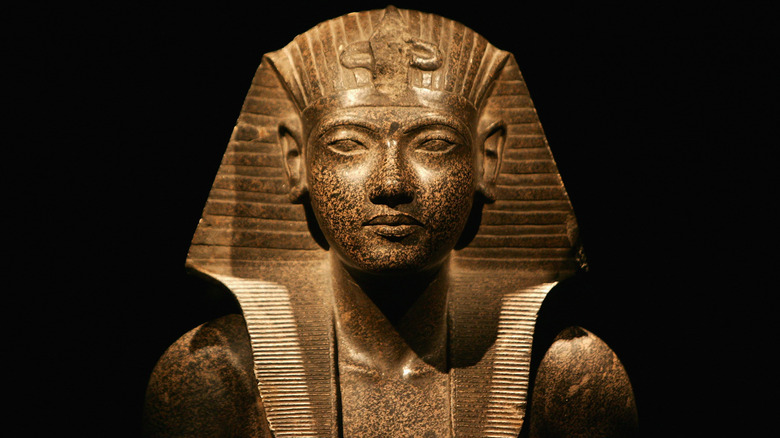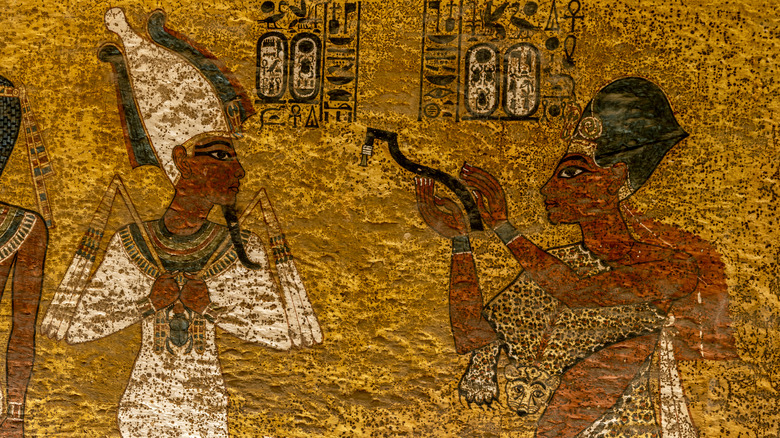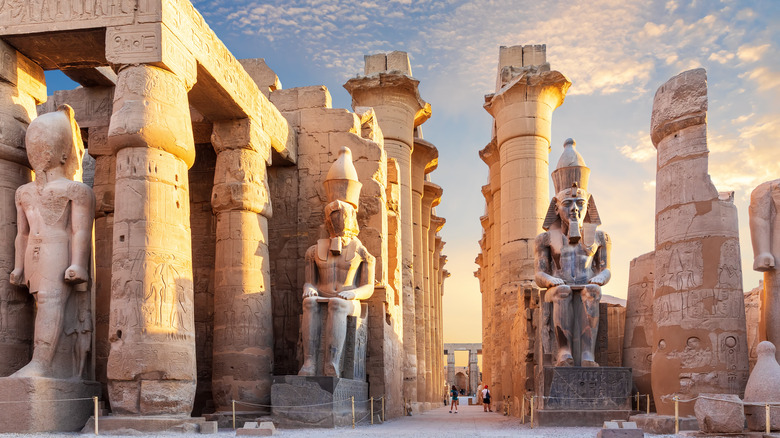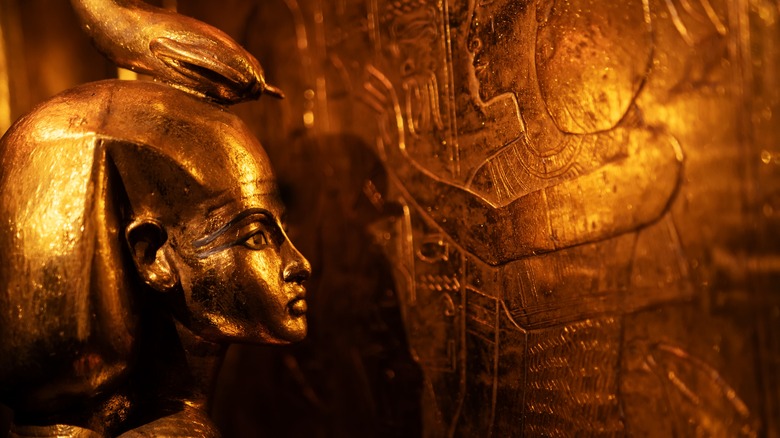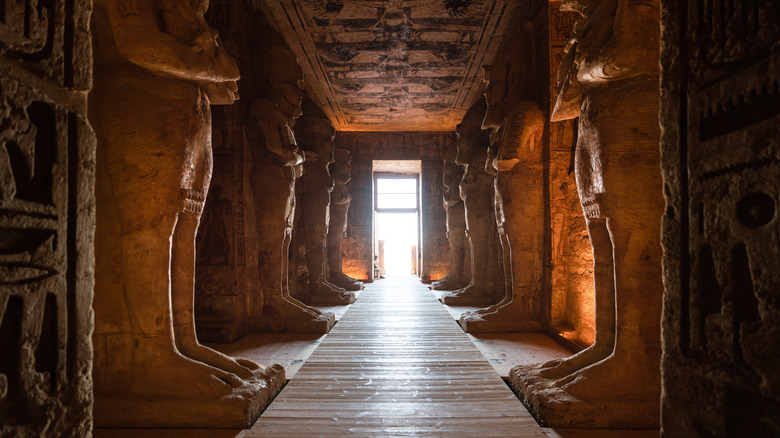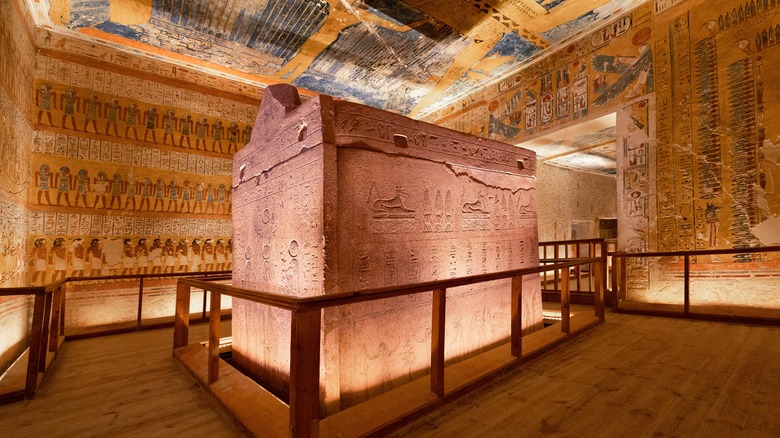Rules King Tut's Subjects Had To Follow
If asked to name a pharaoh of ancient Egypt, many folks would probably chirp "King Tut." After all, "Tut" — short for Tutenkhamun — is just one syllable. It's much easier for English speakers to remember than Peftjaubast, or Djedkhonsefankh, or Netjerkare Siptah. See? Tut it is.
But given Tut's fame, folks might be surprised to learn that his tomb was discovered only about 100 years ago in 1922. Tut was just one more pharaoh out of 170 or so spanning about 2,600 years. He and his grave goods sat undisturbed in the Valley of the Kings, part of the ancient Egyptian city of Thebes and home to about 450 years' worth of dead rulers.
It's Tut's grave goods — plus the absolutely jaw-droppingly pristine condition of his tomb — that make him stand out. We've got hieroglyph-coated walls, a checkers-like board game, gold sandals, 413 figurines of servants to follow Tut into the afterlife, a golden shrine containing Tut's preserved organs, Tut's famed golden mask, and a three-layered, nested sarcophagus with Tut in the smallest one. Tut took the throne at 9 years old and died as a teenager after a short, roughly nine-year reign in 1323 B.C.E.
But for such a young man with a short reign, Tut did make an impact. He reversed the radical monotheism of the previous pharaoh, Akhenaten, who swept away thousands of years of religious tradition in favor of a new religion focused on a single sun god, Aton. The rules of Tut's reign redress this social grievance, while other rules were typical of all pharaohs.
Pharoah: arbiter of law and justice
Overall, the Rosicrucian Egyptian Museum explains that we don't have too many sources explaining the minutiae of King Tutankhamun's reign. He was a kid when he took the throne, married his sister, died at around 17 to 19, depending on the source, of an unknown reason believed to be an accident or disease, and that's that. He's not even listed in records of kings like his relatives, and his parentage isn't clear. What we know about his reign comes largely from inference based on what occurred in Egypt after his death, plus what information we have about the roles of pharaohs in Egyptian society in general. That role centers on "maat," the cosmic order of right, wrong, justice, and law that defined Egyptian society.
As Fundamina, a Journal of Legal History says, Egyptian pharaohs were considered intercessors between the gods and humanity (a vertical relationship) and arbiters of justice between humanity and itself (a horizontal relationship). A pharaoh's primary duty was to uphold maat as a representative of the gods and "supreme judge and law giver." Egyptian religion and Egyptian law were two sides of the same coin.
But, unlike some civilizations, Egyptian law wasn't written in literal stone. Power flowed from the living pharaoh, who responded on a case-by-case basis and had absolute, final say. The pharaoh's judgment, flowing from maat, was "fluid, organic, and changing with the times," as National Geographic puts it. By definition, this means that pharaonic rules — including King Tut's — derived from common sense rather than anything prescriptive. But whatever the pharaoh said, went.
King Tut reversed the rules of the previous pharaoh, Akhenaten
It's hard to impress on the reader the magnitude of ancient Egyptian architecture, temples, statues, etc., without seeing them in person. The size and grandeur is perfectly indicative of how crucial Egyptian heritage and beliefs were to commoners and nobility alike, the pharaoh included. Egypt considered itself an eternal, unchanging kingdom that would always be, built in harmony with the gods and cosmic order. In fact, it's hard to even speak of the word "religion" in a modern, often monotheistic sense when thinking of ancient Egypt. It was just life.
This is why King Akhenaten's reign was radical and extreme beyond measure. With one snap of the fingers he wiped away all of Egyptian tradition, replaced its pantheon with one god, "Aton" (the sun), changed his capital to a place north of Thebes called Akhetaton ("Horizon of the Aton"), changed his name from Amenhotep to Akhenaten ("Beneficial to Aton"), changed his wife's name from Nefertiti to Neferneferuaten ("Beautiful Is the Beauty of Aton"), and more. And because he was pharaoh there was nothing anyone could do, clergy included.
It took another pharaoh to overturn Akhenaten's rules, and it didn't take long, either. The very next pharaoh, Tutankhamun, snapped his fingers and reversed Akhenaten's monotheistic sun god radicalism. Tutankamun was actually born Tutankhaten ("The Living Image of Aton") and changed his name to reflect his shift back to the old ways. And just like when Akhenaten changed Egypt's religious course, everyone else had to follow.
King Tut reinstituted traditional clerical roles and rituals
Like we said before: The decrees of pharaohs were law, those decrees were based on common sense in accordance with maat (cosmic order/justice), and those decrees were not standardized over time and written down (i.e., steal someone's sandals and receive a fine). At the same time, because Egyptian spiritual life permeated everyday life, the gods required a lot of propitiation to maintain cosmic order. To this end, Egyptian priests and priestesses had loads of ongoing, maintenance type rituals to perform all the time, day after day. Their sole function boiled down to caring for the gods and keeping them happy, while everyday citizens dealt with what you'd expect: family, farming, commerce, leisure, etc.
While pharaohs like King Tutankhamun didn't invent rules for Egyptian clergy to follow, Tut's reversal of Akhenaten's laws meant that he returned clergy to their original duties. One day, those clergy had to swap all their tasks for Akhenaten's new religion around 1353 to 1351 B.C.E., and 17 years later after Akhenaten died they swapped back.
By King Tut's decree, clergy returned to their traditional gods and jobs, including custodial staff, cooks, scribes, porters, musicians, dancers, astronomers, fortune tellers, doctors, various clergy responsible for festivals, funerals, pre-funeral organ extraction, oratory at public events, teaching other clergy — basically anyone who worked at a temple. These individuals followed highly-prescriptive rules developed over thousands of years and pre-dating 3,000 B.C.E. But, pharaohs didn't invent these rules. Pharaohs were like high priests interpreting the gods' will, and other priests carried out the pharaoh's will, in turn.
King Tut ordered that followers of Aton not be persecuted
We mentioned that we don't have a lot of specifics about King Tutankhamun's reign beyond his pivot away from Akhenaten's religion of the son god, Aton. But, we do know a couple other key decrees that he made during his time as pharaoh. These decisions portray King Tut as generous, even merciful. Namely: He ordered the restoration of old temples while simultaneously ordering that followers of Aton not be persecuted. And when the pharaoh spoke, people obeyed.
During Akhenaten's 17-year-long reign, temples and shrines to the old gods had fallen into disrepair. Tut ordered the restoration of these structures in accordance with his overall back-to-tradition approach to Egyptian religion. On top of this, he ordered the construction of new buildings, including a palace at Karnak and a Colonnade at the Temple of Luxor, the latter of which was decorated with scenes of traditional gods — presumably just to drive home the point.
At the same time, Tut didn't interfere with those people who'd taken to worshipping Aton. Rather, he ordered these people to be left alone so they could practice whatever religion they wish. This, of course, is in keeping with the ethos of polytheistic religions. Whether this was out of a desire to reconcile a divided people is unknown, but does make sense. Tut even went so far as to not rename certain elements of Egyptian administration named after Aton, like the royal vineyards and particular army regiments.
King Tut's unconventional tomb
We've avoided talking about one big component of ancient Egyptian belief simply because it's such an enormous topic. It also relates to King Tutankhamun, rules laid our during his life, and rules related to pharaohs in general. That is: the Egyptian afterlife. In many ways, Egypt's religious traditions — pleasing the gods, maintaining order and justice on Earth, etc. — were merely preparation for the afterlife. In fact, it's not an exaggeration to say that Egyptians viewed life as a gateway to eternity, one where people were judged based on their earthly actions. Hence the whole mummy thing, as preservation of the physical body aided the journey to the afterlife.
King Tut would have believed no differently. While we don't know if Tut laid out specific plans for what to do with his body after he died, we know that such rules were implicit and would have been followed as a matter of course — he was a pharaoh, after all. That being said, it seems like Tut was buried in a location not originally intended for him, even a chamber converted for another purpose. But, this chamber's small size and circumspect location helped keep it intact for nearly 3,000 years, from Tut's death in 1323 B.C.E. to 1922. Hence all of the artifacts we mentioned found in Tut's tomb: his golden mask, golden slippers, the special shrine for his organs, etc. We don't know if Tut requested such things directly, but crafting his burial chamber was definitely a rule, nonetheless.
